1
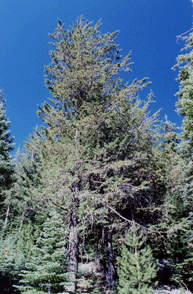
|
Cupressus bakeri
- Trees
The two small trees in the foreground are Pinus contorta ssp. murrayana, and Abies magnifica. Abies lowiana and Pinus jeffreyi are also common in the area.
Near Mud Lake, Plumas National Forest.
California
|
2

|
Cupressus bakeri
- Trees
In the Plumas National Forest are growing the most southern groves of Cupressus bakeri.That location has the largest trees of this species to about 85 feet tall. The forest is quite similar to the forest at Sierra San Pedro Martir where Cupressus arizonica montana are found. They were growing among Pinus jeffreyi, Pinus contorta murrayana, Abies lowiana and Populus tremuloides. All of those trees where also growing around the Cupressus arizonica montana trees. Pinus lambertiana, which grows in San Pedro Martir, was not present in the immediate vicinity, but was growing at alittle lower elevation a few miles away. The only species not present at Sierra San Pedro that was growing with Cupressus bakeri was Abies magnifica. The trees where growing at 6,900 feet, within the sub-alpine forest. At that altitude in the Northern Sierra very heavy snow accumulates in winter, 10 feet or more on a normal year, and last well into June. They were on a Northeast exposure, which is the coldest exposure. Quite unusual climate for Cupressus. The cones collected last
year at Timbered Crater were at much lower elevation in a warmer and drier climate, growing with Pinus attenuata, Pinus ponderosa, Pseudotsuga menziesii, and Juniperus occidentalis being the most common. From a distance it was
hard to tell Cupressus bakeri from Juniperus occidentalis. The Cupressus bakeri trees here are growing in a dense forest. The ones at Timbered Crater are in an open forest, growing on lava beds.
Near Mud Lake, Plumas National Forest.
California
|
3

|
Cupressus bakeri
- Trees
Abies magnifica is growing in the forground.
Near Mud Lake, Plumas National Forest.
California
|
4
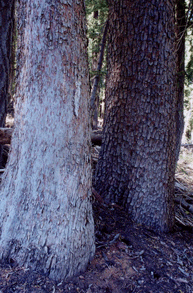
|
Cupressus bakeri
- Trunks
Trunks of two large trees (about 80 feet tall).
These trees are growing at about 6,900 feet.
Near Mud Lake, Plumas National Forest.
California
|
5
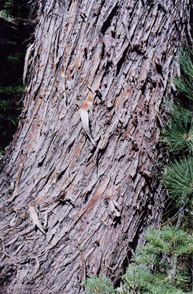
|
Cupressus bakeri
- Bark
This area receives heavy winter snowfall which accumulates to 10 feet or more on a normal winter. Many of the trunks where bent at the bottom from the weight of the snow, which does not melt untill June on a normal year. The trunks are shaped when young, and continue to grow crooked when the trees are large. Foliage of Pinus jeffreyi and Abies magnifica are also seen in this photo.
Near Mud Lake, Plumas National Forest.
Altitude : 6,900 feet.
California
|
6
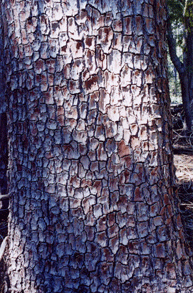
|
Cupressus bakeri
- Bark
Near Mud Lake, Plumas National Forest.
California
|
7

|
Cupressus bakeri
- Bark
Smooth bark of young tree growing near Mud Lake, Plumas National Forest.
California
|
8

|
Cupressus bakeri
- First year cones
From tree near Mud Lake, Plumas National Forest.
Altitude : 6,900 feet.
California
|
9

|
Cupressus bakeri
- Cones
Near Mud Lake, in Plumas National Forest.
California
|
10
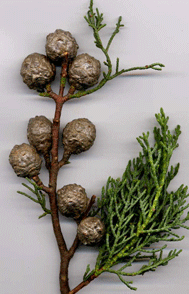
|
Cupressus bakeri
- Cones
From Mud Lake, Plumas National Forest.
One of two most southern groves.
California
|
11
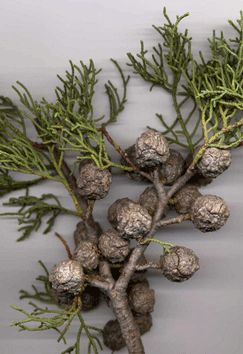
|
Cupressus bakeri
- Cones
Near Mud Lake, Plumas National Forest.
California
|
12
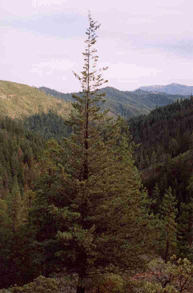
|
Cupressus bakeri
- Trees
These trees are growing at about 2,000 feet with Pinus jeffreyi, Pinus attenuata, Pseudotsuga menziesii and Calocedrus decurrens.
Seiad Valley.
California
|
13
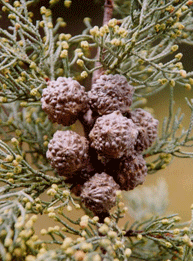
|
Cupressus bakeri
- Cones
Some botanist distinguish the trees in Northwestern California and Southwestern Oregon as subspecies matthewsii. The cones in this area are about twice the size of the ones in Plumas and Lassen counties of Northern California, and some say the foliage is greener in the northwestern populations.
Seiad Valley, near Happy Camp.
California
|
14
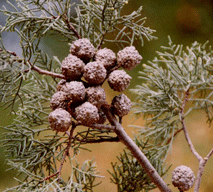
|
Cupressus bakeri
- Cones
Seiad Valley.
California
|
|